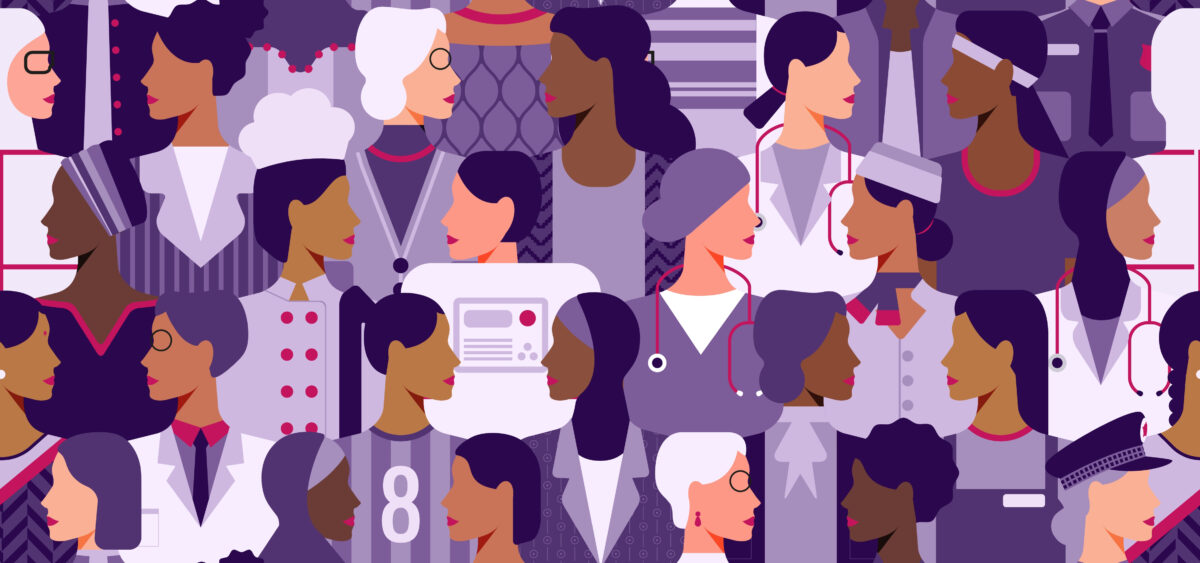
The History of Women’s Equality Day and Why Intersectionality is Still Important
August 26th marks Women’s Equality Day, a holiday that commemorates the 19th Amendment to the U.S. Constitution, which granted women the right to vote.
That being said, while the suffrage movement was a milestone for women’s rights, we must also acknowledge that it did not fully encompass the experiences of all women.
Here’s why we must keep the concept of intersectionality in mind as we celebrate this holiday:
The History of Women’s Equality Day
Women’s Equality Day was designated as a national holiday in 1973, created in order to recognize the hard-fought battle for women’s suffrage in 1920. Mere days prior, on August 18, Congress officially ratified the 19th Amendment, which solidified the right of most American women the right vote.
That being said, it only represented one step towards equality for all women.
Black women and women of color were still facing significant barriers to voting, as well as employment, education, and other opportunities. In fact, it wouldn’t be until 1965 — a full 45 years later — that Black women would be granted the same voting rights.
All About Intersectionality
As we celebrate Women’s Equality Day, it’s crucial to recognize the importance of intersectionality in our understanding and advocacy for gender equality.
Intersectionality, a term coined by Kimberlé Crenshaw, reminds us that women’s experiences are not homogeneous and are significantly influenced by other aspects of their identities such as race, class, sexual orientation, and disability status.
Recognizing intersectionality ensures that we don’t just fight for the equality of women in a monolithic sense, but that we advocate for all women, acknowledging and addressing the unique challenges faced by those who belong to multiple marginalized groups.
In this way, intersectionality enriches our understanding of women’s rights and helps us build a more inclusive and equitable society.
S.H.E. Matters During and Beyond Women’s Equality Day
Employers must consider the ways in which various systems of oppression can impact their employees.
The pay gap, for example, is not simply an issue of gender; it is influenced by race and ethnicity, as well as other factors. Understanding these intersections is crucial when working to create an equitable workplace.
Overall, Women’s Equality Day is an important reminder of the progress that has been made over the years, but it is also an opportunity to analyze the work that still needs to be done to achieve true equality.
But what do you think? We’d love to hear from you!
Please reach out to us or visit our S.H.E. Matters page to send in a submission for our review, and stay tuned here for more information!

S.H.E. Matters After She Retires: Long-Term Effects of the Gender Pay Gap on Women’s Retirement Savings
Retirement planning isn’t an easy task for anyone, regardless of what stage of life they’re in. However, recent retirement discussions have highlighted that women face an additional challenge in saving for the future: the gender pay gap.
As employers or business owners, it’s vital to address this issue for the economic security of your female employees.
Let’s take a look at the long-term effects of the gender pay gap on women’s retirement savings and the steps that businesses can take…
Lower retirement savings mean lower Social Security benefits
The gender pay gap means women are paid less during their working years, resulting in lower retirement savings than their male counterparts. Since Social Security payments are based on an employee’s income during their working years, a lower salary would result in a lower benefit amount.
This issue would also result in women having a smaller retirement nest egg to rely on during their retirement years.
Longer life expectancies
Women, on average, live longer than men. According to Harvard Health, “57% of all those ages 65 and older are female. … The average lifespan is about 5 years longer for women than men in the U.S., and about 7 years longer worldwide.”
Due to these longer life expectancies, women have higher medical expenses, living expenses, and caregiver expenses, which, combined with lower retirement savings, often result in greater financial insecurity later in life.
Lack of retirement plan access
Women face an additional challenge as they are often employed in small businesses that don’t offer retirement plans like 401(k) and pensions.
In fact, “About 50% of women ages 55 to 66 have no personal retirement savings, compared to 47% of men,” as reported by the U.S. Census Bureau. The lack of retirement plan access means that women have to be even more proactive about saving for retirement.
Other factors
Women face additional challenges in saving for retirement due to factors such as career interruptions, taking time off for caregiving, and other responsibilities. These challenges result in women earning less from work, saving less for retirement, and relying more on Social Security in retirement.
What employers and business owners can do
Simply put, businesses can address these issues by implementing transparent compensation policies and practices. This step would ensure that all employees are paid equitably, regardless of gender.
Additionally, offering retirement plans like 401(k) programs can improve access to retirement planning for all employees in the company. Employers can also support career development opportunities for women, to improve their earnings and increase their ability to save for their retirement years.
But what do you think? Are you a woman with a unique perspective on saving for retirement or a business owner that offers these kinds of benefits? We’d love to hear from you!
Please reach out to us or visit our S.H.E. Matters page to send in a submission for our review, and stay tuned here for more information!

(S.H.E. Matters) Creating an Inclusive Workplace: 5 Best Practices for Promoting Diversity and Equality
Diversity and inclusion is a critical aspect of any workplace. Employers have a responsibility to create an environment that emphasizes inclusion, diversity, and equity in all aspects of the organization.
The benefits of having a diverse team are significant and go far beyond inclusion and fairness; it creates an environment that fosters innovation and creativity through the collaboration of different perspectives and ideas.
In this blog post, we will explore some of the best practices for promoting diversity and equality in your workplace.
#1 — Develop a Diversity, Equity, and Inclusion Plan
Creating an effective Diversity, Equity, and Inclusion (DEI) plan is the first step toward building a more inclusive workplace. Developing a comprehensive and data-driven DEI plan requires a thorough assessment of your organization’s current diversity landscape.
Overall, it involves creating a long-term strategy that encompasses current and future initiatives within the organization.
This plan should focus on creating an inclusive workplace by identifying diverse talent, providing employee education, and creating an environment that encourages innovation and creativity through diversity.
#2 — Address Unconscious Bias
Unconscious bias is a type of bias that is inherent in the human psyche.
In this case, “Unconscious gender bias is defined as unintentional and automatic mental associations based on gender, stemming from traditions, norms, values, culture and/or experience,” the International Labour Organization (ILO) explains. “Automatic associations feed into decision-making, enabling a quick assessment of an individual according to gender and gender stereotypes.”
Addressing the hidden unconscious biases is one of the best practices for promoting diversity and inclusion objectives in the workplace. Employees need to undergo continuous training on recognizing, identifying, and addressing these biases in the workplace to ensure equal opportunity for all employees.
#3 — Foster a Culture of Inclusivity
To create a culture of inclusivity that values and incorporates diverse perspectives, it is essential to prioritize inclusivity as a shared value in all aspects of the organization.
Make sure to integrate policies that are sensitive to the diversity of your workforce.
For example, you may include flexible work arrangements, equal pay for equal work, and maternity and paternity leave, among other policies. This helps to attract, retain and promote diverse talent within the organization.
#4 — Promote Career Advancements Opportunities
To create a culture that values diversity, it is essential to provide equal opportunities for all employees — regardless of gender — to advance their careers. This helps to encourage engagement and promotes diversity throughout the organization.
Simply put, the inclusion of a range of employees at the executive and senior management levels can help promote an inclusive environment at every level of the work environment. In some cases, instituting blind screening processes may help even the playing field.
“By hiding certain characteristics like age, gender, ethnicity, or level of education, you can remove the different cognitive biases that creep up when reading a resume,” Glassdoor explains. “Blind hiring helps us eliminate some of the initial preconceived notions that we might have about candidates (e.g. the candidate’s names) and helps us focus on the applicant’s qualifications and skills.”
#5 — Be Accountable
It is critical for organizations to promote accountability in creating a diverse and inclusive work environment. Data-driven measurements or system assessments should be conducted regularly to ensure that the organization is meeting its intended objectives.
This measurement will help identify the progress of the organization and highlight areas that require improvement. The feedback must be transparent, and corrective action should be taken when teams fail to meet diversity objectives.
When all is said and done, creating a diverse and inclusive workplace is about more than just promoting diversity and equity; it’s about fostering innovation and creating an environment that attracts, retains, and develops diverse talent.
But what do you think? Do you lead or work for a workplace that has implemented any or all of the aforementioned strategies? We’d love to hear from you!
Please reach out to us or visit our S.H.E. Matters page to send in a submission for our review, and stay tuned here for more information!

S.H.E. Matters: Exploring the Glass Cliff Phenomenon and Twitter
The concept of the glass ceiling has been a pervasive issue for women in the workplace for decades. It refers to an invisible barrier that makes it difficult, if not impossible, for women to rise up into higher positions within companies and industries.
But what about those who have made it past this barrier, only to face another incredible hurdle?
In this blog post, we will explore what the glass cliff is and how it affects female executives today, with a particular focus on Linda Yaccarino’s recent appointment as CEO of Twitter following Elon Musk’s short-lived and tumultuous tenure at the helm.
What is the Glass Cliff?
Built off the concept of the glass ceiling, “The glass cliff refers to the phenomenon whereby women (and members of other minority groups, such as those based on race or disability) are over-represented in leadership positions that are risky and precarious,” as explained by the University of Exeter.
This phenomenon was first identified by University of Exeter colleagues Michelle Ryan and Alex Haslam in 2003 after they studied the appointment of female CEOs within the FTSE 100.
Specifically, they discovered that companies were more likely to appoint a female CEO during times of economic crisis or when the company was at risk of failure.
This finding demonstrates that women and minority employees can be unfairly placed in positions of greater responsibility without proper support or preparation, thus leaving them more likely to fail than their white male counterparts.
Some arguments point to the fact that this allows companies to appoint a woman as a scapegoat should she be unable to pull the business out of a downward spiral, all while gaining praise for their “diversity efforts.” They are then free to appoint another male CEO without much backlash.
Others, however, argue that there is insubstantial research into and evidence supporting this phenomenon, thereby dubbing it the “glass cliff myth.”
(Allegedly) Witnessing the Glass Cliff in Real Time
Why is the glass cliff relevant today? Simple: After Elon Musk announced that advertising executive Linda Yaccarino would take over as the new CEO of Twitter — following an onslaught of perceived business blunders by Musk himself — the glass cliff debate resurfaced.
“In addition to Yaccarino, Ellen Pao’s appointment at Reddit, Mary Barra at GM, Carly Fiorina at HP and Marissa Mayer at Yahoo are often cited examples of women promoted to top management at distressed companies,” as reported by Forbes.
This is especially notable given the rarity of female executives in tech, let alone at Twitter in specific.
Since taking the helm at Twitter, Musk has been scrutinized for firing top company executives, enacting mass layoffs (roughly 80% of the company workforce), upsetting the existing verification systems, and enacting overall changes that led many prominent advertisers to pull away from the platform entirely.
Following a slew of criticism and a self-promoted Twitter poll through which he asked his followers if he “should step down as the head of Twitter,” Musk promised to appoint a new CEO who would oversee the platform’s business operations.
Enter: former NBCUniversal ad chief Yaccarino.
“She is exactly what Twitter needs to start rebuilding advertiser trust, bring back big advertisers and really start improving Twitter’s ad business,” Insider Intelligence analyst Jasmine Enberg told AP News. “That said, there are still a lot of challenges and Yaccarino is going to have her hands full from day one.”
As a result, many have been left wondering: Did Musk leave Yaccarino teetering on the edge of a glass cliff at Twitter HQ?
SHE Matters — Even If She Teeters On the Edge
But what do you think?
Do you think Yaccarino is facing a glass cliff? Or do you know another woman placed in a similar position who overcame and conquered at the edge?
Please reach out to us or visit our S.H.E. Matters page to send in a submission for our review, and stay tuned here for more information!

S.H.E. Matters: Counting Dollars Through the Years With the Age Gap
The wage gap between men and women is still a reality today, with the gap only widening as women age. In fact, women often face lower wages than their male counterparts due to occupational segregation, unconscious biases, and discrimination, among other things.
This issue has long-reaching implications for individuals, our economy, and our society at large. But in this particular blog post, we’ll look at the Age Gap: an intersection of gender and age that underscores these disparities in the workplace.
Let’s explore what it is, how it works, and more…
What Are the Basics of the Age Gap?
As women progress in their careers, they encounter even greater disparities in wages compared to their male counterparts.
Thus, as the wage gap widens as they age, women in their retirement years are left with significantly less financial security than men.
“Earnings gaps represent a prime reason why women, especially widows and divorced women or those who never married, experience higher rates of poverty in old age than men,” as explained by the Center for American Progress (CAP).
We can see this growing wage gap at the intersection of age and gender as illustrated by the U.S. Department of Labor’s research:
- Ages 16 to 19: 10% gap
- Ages 20 to 24: 7.1% gap
- Ages 25 to 34: 9.8% gap
- Ages 34 to 44: 17.9% gap
- Ages 45 to 54: 20.8% gap
- Ages 55 to 64: 22.2% gap
- Ages 65 and Over: 26.9% gap
How Does the Age Gap Work?
One reason the wage gap is exacerbated over a woman’s lifetime is because of the tendency for women to be overlooked for promotions and leadership positions, even when they possess the same skills and experience as their male colleagues.
Additionally, gender stereotypes and biases can lead to a devaluation of traditionally female-dominated roles, resulting in lower salaries for women working in these fields.
Another factor that contributes to the wage gap for older women is the impact of caregiving responsibilities on their careers — often referred to as “the motherhood penalty” in most familial cases.
Women are more likely to take time off from work to care for family members, which can interrupt their career trajectories and result in lower earnings over time. Moreover, women who do return to work after a break for caregiving responsibilities may face challenges in finding equal pay and opportunities for advancement.
But with that all in mind, when are women most likely to begin feeling the effects of this age gap?
“After around 40, women’s wage growth plateaus and then drops off earlier than men’s,” according to the Economic Policy Institute (EPI). “This holds true when measuring the gap using median weekly earnings of full-time wage and salary workers”
She Matters Today… and Tomorrow
It is imperative that we recognize and address the persistent wage gap for women, especially as they grow older. A fair and equitable workplace benefits not only individual women, but also the larger economy and society.
Efforts to close the wage gap must take into account the nuanced and complex factors that contribute to it, including occupational segregation, unconscious biases, and discrimination.
By doing so, we can promote equal pay for all workers, regardless of gender.
But what do you think? Are you a female worker who is already feeling the impacts of all the aforementioned? Or do you have another point of view on the age gap? We’d love to hear from you!
Please reach out to us or visit our S.H.E. Matters page to send in a submission for our review, and stay tuned here for more information!


